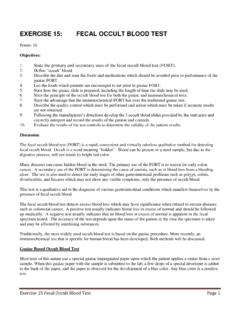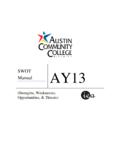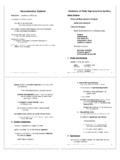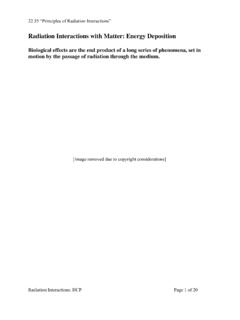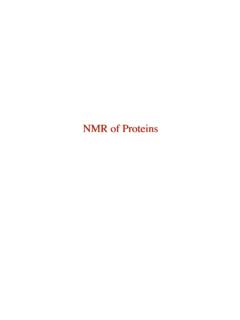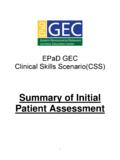Transcription of Sample Exercise 16.1 Identifying Conjugate Acids and Bases
1 Sample Exercise Identifying Conjugate Acids and Bases (a) What is the Conjugate base of each of the following Acids : HClO4, H2S, PH4+, HCO3 ? (b) What is the Conjugate acid of each of the following Bases : CN , SO42 , H2O, HCO3 ? Solution Analyze: We are asked to give the Conjugate base for each of a series of species and to give the Conjugate acid for each of another series of species. Plan: The Conjugate base of a substance is simply the parent substance minus one proton, and the Conjugate acid of a substance is the parent substance plus one proton. Solve: (a) HClO4 less one proton (H+) is ClO4 . The other Conjugate Bases are HS , PH3, and CO32 . (b) CN . plus one proton (H+) is HCN. The other Conjugate Acids are HSO4 , H3O+, and H2CO3. Notice that the hydrogen carbonate ion (HCO3 ) is amphiprotic. It can act as either an acid or a base. Practice Exercise Write the formula for the Conjugate acid of each of the following: HSO3 , F , PO43 , CO.
2 Answers: H2SO3, HF, HPO42 , HCO+. Chemistry: The Central Science, Eleventh Edition Copyright 2009 by Pearson Education, Inc. By Theodore E. Brown, H. Eugene LeMay, Bruce E. Bursten, and Catherine J. Murphy Upper Saddle River, New Jersey 07458. With contributions from Patrick Woodward All rights reserved. Sample Exercise Writing Equations for Proton- transfer Reactions The hydrogen sulfite ion (HSO3 ) is amphiprotic. (a) Write an equation for the reaction of HSO3 with water, in which the ion acts as an acid. (b) Write an equation for the reaction of HSO3 with water, in which the ion acts as a base. In both cases identify the Conjugate acid base pairs. Solution Analyze and Plan: We are asked to write two equations representing reactions between HSO3 and water, one in which HSO3 should donate a proton to water, thereby acting as a Br nsted Lowry acid, and one in which HSO3 should accept a proton from water, thereby acting as a base.
3 We are also asked to identify the Conjugate pairs in each equation. Solve: The Conjugate pairs in this equation are HSO3 (acid) and SO32 ( Conjugate base); and H2O (base) and H3O+. ( Conjugate acid). The Conjugate pairs in this equation are H2O (acid) and OH ( Conjugate base), and HSO3 (base) and H2SO3. ( Conjugate acid). Practice Exercise When lithium oxide (Li2O) is dissolved in water, the solution turns basic from the reaction of the oxide ion (O2 ) with water. Write the reaction that occurs, and identify the Conjugate acid base pairs. Answer: O2 (aq) + H2O(l) OH (aq) + OH (aq). OH is the Conjugate acid of the base O2 . OH is also the Conjugate base of the acid H2O. Chemistry: The Central Science, Eleventh Edition Copyright 2009 by Pearson Education, Inc. By Theodore E. Brown, H. Eugene LeMay, Bruce E. Bursten, and Catherine J. Murphy Upper Saddle River, New Jersey 07458.
4 With contributions from Patrick Woodward All rights reserved. Sample Exercise Predicting the Position of a Proton- transfer Equilibrium For the following proton- transfer reaction, use Figure to predict whether the equilibrium lies predominantly to the left (that is, Kc < 1 ) or to the right (Kc > 1): Solution Analyze: We are asked to predict whether the equilibrium shown lies to the right, favoring products, or to the left, favoring reactants. Plan: This is a proton- transfer reaction, and the position of the equilibrium will favor the proton going to the stronger of two Bases . The two Bases in the equation are CO32 , the base in the forward reaction as written, and SO42 the Conjugate base of HSO4 . We can find the relative positions of these two Bases in Figure to determine which is the stronger base. Solve: CO32 appears lower in the right-hand column in Figure and is therefore a stronger base than SO42.
5 CO32 , therefore, will get the proton preferentially to become HCO3 , while SO42 will remain mostly unprotonated. The resulting equilibrium will lie to the right, favoring products (that is, Kc > 1 ). Comment: Of the two Acids in the equation, HSO4 and HCO3 , the stronger one gives up a proton more readily while the weaker one tends to retain its proton. Thus, the equilibrium favors the direction in which the proton moves from the stronger acid and becomes bonded to the stronger base. Practice Exercise For each of the following reactions, use Figure to predict whether the equilibrium lies predominantly to the left or to the right: Answers: (a) left, (b) right Chemistry: The Central Science, Eleventh Edition Copyright 2009 by Pearson Education, Inc. By Theodore E. Brown, H. Eugene LeMay, Bruce E. Bursten, and Catherine J. Murphy Upper Saddle River, New Jersey 07458.
6 With contributions from Patrick Woodward All rights reserved. Sample Exercise Calculating [H+] for Pure Water Calculate the values of [H+] and [OH-] in a neutral solution at 25 C. Solution Analyze: We are asked to determine the concentrations of H+ and OH ions in a neutral solution at 25 C. Plan: We will use Equation and the fact that, by definition, [H+] = [OH ] in a neutral solution. Solve: We will represent the concentration of [H+] and [OH ] in neutral solution with x. This gives In an acid solution [H+] is greater than ; 10 7 M in a basic solution [H+] is less than 10 7 M. Practice Exercise Indicate whether solutions with each of the following ion concentrations are neutral, acidic, or basic: (a) [H+] = 4 10 9 M ; (b) [H+] = 4 10 9 M ; (c) [OH ] = 7 10 13 M . Answers: (a) basic, (b) neutral, (c) acidic Chemistry: The Central Science, Eleventh Edition Copyright 2009 by Pearson Education, Inc.
7 By Theodore E. Brown, H. Eugene LeMay, Bruce E. Bursten, and Catherine J. Murphy Upper Saddle River, New Jersey 07458. With contributions from Patrick Woodward All rights reserved. Sample Exercise Calculating [H+] from [OH-]. Calculate the concentration of H+(aq) in (a) a solution in which [OH ] is M, (b) a solution in which [OH ] is 10 9 M . Note: In this problem and all that follow, we assume, unless stated otherwise, that the temperature is 25 C. Solution Analyze: We are asked to calculate the hydronium ion concentration in an aqueous solution where the hydroxide concentration is known. Plan: We can use the equilibrium-constant expression for the autoionization of water and the value of Kw to solve for each unknown concentration. Solve: a) Using Equation , we have: This solution is basic because (b) In this instance This solution is acidic because Practice Exercise Calculate the concentration of OH (aq) in a solution in which (a) [H+] = 2 10 6 M; (b) [H+] = [OH ].
8 (c) [H+] = 100 [OH ]. Answers: (a) 5 10 9 M, (b) 10 7 M, (c) 10 8 M. Chemistry: The Central Science, Eleventh Edition Copyright 2009 by Pearson Education, Inc. By Theodore E. Brown, H. Eugene LeMay, Bruce E. Bursten, and Catherine J. Murphy Upper Saddle River, New Jersey 07458. With contributions from Patrick Woodward All rights reserved. Sample Exercise Calculating pH from [H+]. Calculate the pH values for the two solutions described in Sample Exercise Solution Analyze: We are asked to determine the pH of aqueous solutions for which we have already calculated [H+]. Plan: We can calculate pH using its defining equation, Equation Solve: (a) In the first instance we found [H+]. to be 10 12 M. Because 10 12 has two significant figures, the pH has two decimal places, (b) For the second solution, [H+] = 10 6 M. Before performing the calculation, it is helpful to estimate the pH.
9 To do so, we note that [H+] lies between 1 10 6 and 1 10 5. Thus, we expect the pH to lie between and We use Equation to calculate the pH. Check: After calculating a pH, it is useful to compare it to your prior estimate. In this case the pH, as we predicted, falls between 6 and 5. Had the calculated pH and the estimate not agreed, we should have reconsidered our calculation or estimate or both. Practice Exercise (a) In a Sample of lemon juice [H+] is 10 4 M. What is the pH? (b) A commonly available window- cleaning solution has [OH ] = 10 6 M . What is the pH? Answers: (a) , (b) [H+] = 10 9 M, so pH = Chemistry: The Central Science, Eleventh Edition Copyright 2009 by Pearson Education, Inc. By Theodore E. Brown, H. Eugene LeMay, Bruce E. Bursten, and Catherine J. Murphy Upper Saddle River, New Jersey 07458. With contributions from Patrick Woodward All rights reserved.
10 Sample Exercise Calculating [H+] from pH. A Sample of freshly pressed apple juice has a pH of Calculate [H+]. Solution Analyze: We need to calculate [H+] from pH. Plan: We will use Equation , pH = log[H+], for the calculation. Solve: From Equation , we have Thus, To find [H+] , we need to determine the antilog of Scientific calculators have an antilog function (sometimes labeled INV log or 10x) that allows us to perform the calculation: Comment: Consult the user's manual for your calculator to find out how to perform the antilog operation. The number of significant figures in [H+] is two because the number of decimal places in the pH is two. Check: Because the pH is between and , we know that [H+] will be between 1 10 3 and 1 10 4 M. Our calculated [H+] falls within this estimated range. Practice Exercise A solution formed by dissolving an antacid tablet has a pH of Calculate [H+].


